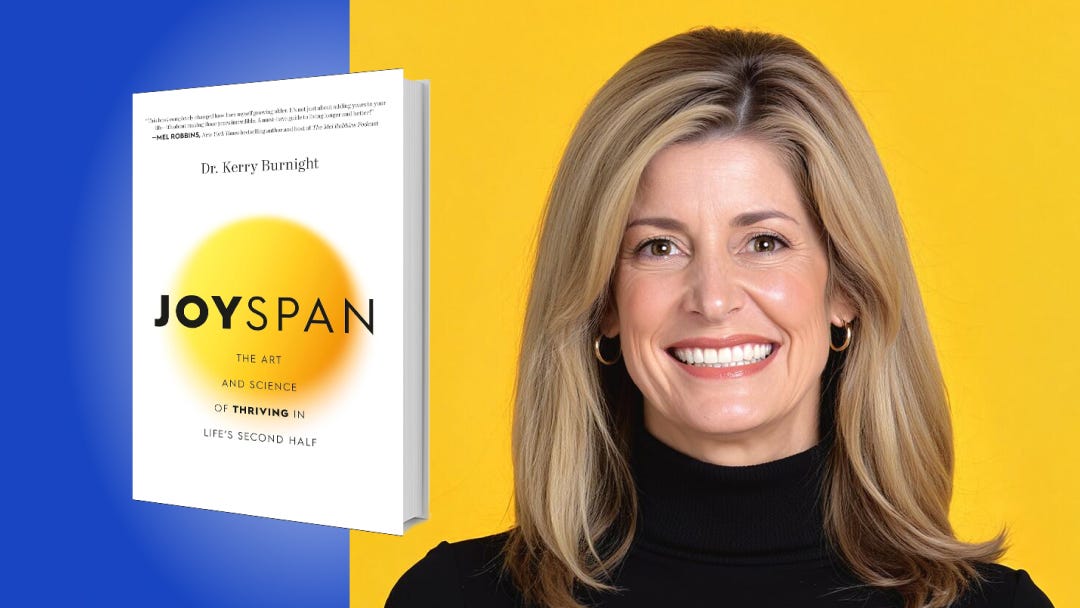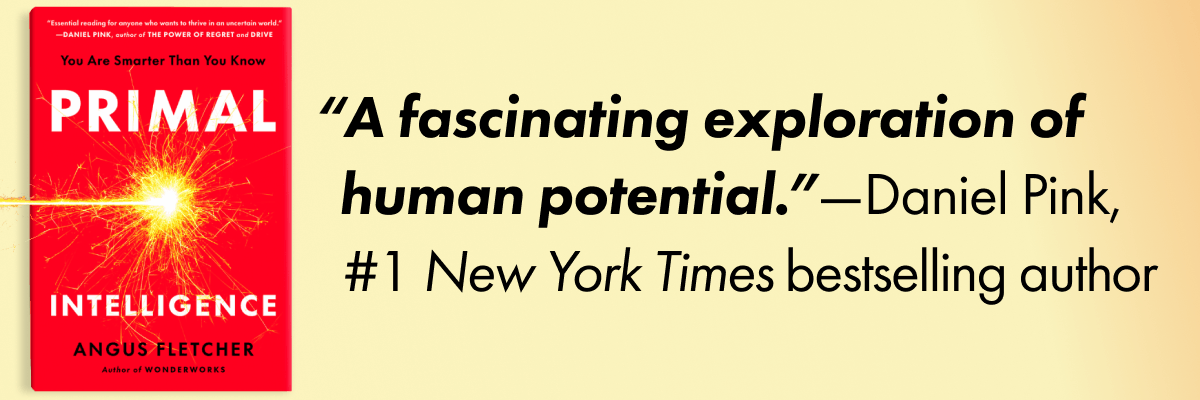Anti-Aging Is Overrated. Joy Is the Real Fountain of Youth
Living longer is good. Living with joy, purpose, and connection is better—and it’s within your reach.
Listen now on Spotify or Apple Podcasts:
When we talk about aging, we often hear about lifespan—how long you live—or healthspan—how well you live. But what about joyspan? That’s the question gerontologist Dr. Kerry Burnight is asking in her new book by that name, Joyspan: The Art and Science of Thriving in Life's Second Half.
Kerry taught geriatric medicine and gerontology for nineteen years at the University of California Irvine School of Medicine. Drawing on decades of research in aging and elder care, she argues that longevity, even healthy longevity, isn’t the goal—joyful longevity is. The people who thrive into their 80s, 90s, and even 100s aren’t just lucky. They’re doing specific things that keep them engaged, fulfilled, and vibrant. Pick up copy of the book on Amazon, or read her five key insights below.
1. Longevity is just the beginning.
Anyone who says “age is just a number” has not reached the high numbers. Aging isn’t easy, and “forever young” is not a plan. Regardless of how many burpees you can do or protein smoothies you chug, the passing of time brings challenges. Roles that you relished change, words on menus seem to shrink, necks sag, and diagnoses arise.
On the other hand, aging is not the downhill slide that people often believe it to be. A multibillion-dollar antiaging industry profits when you feel awful about yourself and fear aging like the plague. The tragedy of aging is not that we will all grow old and die, but that aging has been made unnecessarily, and at times excruciatingly, painful and humiliating. Aging does not have to be this way.
When it comes to longevity, the primary focus has been upon lifespan, the length of life. More recently, though, the scope has expanded beyond years of life to years of life in good health, or healthspan. This is a welcome shift because we all want to live as healthily as possible for as long as possible.
“A multibillion-dollar antiaging industry profits when you feel awful about yourself and fear aging like the plague.”
But there’s a catch. A long life—even a long life in good health—doesn’t mean much if you don’t like your life. What we’ve been missing is a science-based, how-to guide for maximizing the quality of these long lives. It’s not enough to have a long lifespan and healthspan. We want a long joyspan.
2. The missing piece is joyspan.
Joyspan is the experience of well-being and satisfaction in longevity. The American Psychological Association defines joy as the feeling that arises from a sense of well-being or satisfaction. Experiencing joy is different from feeling happy. Happiness comes and goes and is often dependent on external circumstances.
Joyspan can be experienced even in adverse situations. More akin to contentment than to ecstasy, joy may show up in the form of a smile, but many times it does not. You can’t always ascertain someone’s joy by observing them. One older woman, looking at the trees through her window, may be lonely and miserable, while a different older woman, looking at the same trees, may be experiencing great joy. With a long joyspan, you live a fulfilling, purposeful life despite the challenges that accompany aging.
This week, Book of the Day is brought to you by Primal Intelligence, a new neuroscientific approach to improving mental performance by honing intuition, imagination, emotions, and common sense. Get your copy today.
3. People with long joyspans do these four things.
I scoured the findings of 35 years of empirical testing on psychological well-being in longevity and recognized a profound underlying pattern. The hundreds of predictors found in thousands of studies on what is necessary to thrive in longevity consistently group into four essential elements:
They Grow: They continue to expand and explore.
They Connect: They put time into new and existing relationships.
They Adapt: They adjust to changing and challenging situations.
They Give: They share themselves.
How do you keep on growing? You challenge your brain. Learn new skills. Try something you’ve never done. New experiences activate neuroplasticity, improve cognitive function, and keep your curiosity alive. Whether it’s taking a dance class, learning to code, or reading a new genre, growing promotes vitality.
How do you maintain social connections? Whether you are an introvert or an extrovert, connection is embedded in your biology. A challenge of long lives is that friends and family often pre-decease us, or grow ill or cognitively impaired, or move away. The only way to have robust social connections is to be proactive—to be that friend who reaches out, makes plans, remembers birthdays, and sits beside you in the hospital.
How do you adapt to unwelcome changes? The people who age well aren’t the ones who never struggle. They’re the ones who adapt. Adapting is being able to accept and even embrace change, revise your story, and stay open to new meaning.
How do you find ways to give of yourself in an ageist society? The science is clear: giving is good for you. People who give back—whether by mentoring, listening, or creating—report higher levels of joy, purpose, and longevity. Start small by asking, “Who can I help today?” Reject the ageist notion that you have less to give when you are older. Society desperately needs the qualities that improve with age: problem-solving, emotional regulation, caring less about what others think, an appreciation for nature, humility, and spirituality.
4. Anti-aging decreases joyspan.
From the time we were toddlers, we’ve been exposed to false fear-based messaging that older is bad. Even fairy tales feature old witches who might eat you.
Right now, you hold one of two mindsets: aging as decline or aging as continued growth. The decline mindset believes everything gets worse as you grow older and then you die. Sadly, this mindset is the most prevalent. The growth mindset sees aging as a time of continued progress in becoming who you are. This mindset recognizes not only the challenges and losses associated with growing older but also the opportunities and strengths that come with it.
Take my neighbor Dee, who is 81. A few days ago, I saw her on her front porch while I was walking the dogs, and she waved me over so she could tell me all about her sore hands, the “absolute drivel” on TV, and how bad the hot weather makes her feel. Because Dee sees her life as a downward free fall, she’s stopped showing up for it. She does not pursue her former interests, reach out to friends, or challenge herself. The long hours spent in her recliner have seriously weakened her legs, which she blames on the curse of being old.
“This mindset recognizes not only the challenges and losses associated with growing older but also the opportunities and strengths that come with it.”
Our conversations never have room for topics beyond her discomfort. Despite our many conversations, Dee doesn’t know anything about me other than the fact that I have two golden retrievers. There isn’t any space for me to share my life because her life, as miserable as she finds it, is the topic that dominates her mind. Dee definitely holds a decline mindset.
I often run into another neighbor, Joan, who walks the same loop I do. I absolutely love it when I run into Joan. She is 82 and radiant. Soon after our middle daughter was diagnosed with a brain tumor, I saw Joan, and she noticed right away that something was off. She asked me what was going on in a way that made me feel safe to share. She listened intensely, then suggested ways to adjust to this new normal. Joan has had many new normals. Always very interested in something—a new plant she’s potted, a new recipe, an interesting book, an upcoming art exhibit—Joan has a growth mindset.
Growing older is about actually growing about becoming. Joan knows that interior strengths can continue to develop throughout life. I once told Joan how much I admire her attitude, and she laughed, saying, “I find life fascinating. I’m still growing now, just as I have in every other phase of my life.”
5. Maximizing your joyspan takes work.
The Core Four of joyspan (grow, connect, adapt, give) are all verbs because they take work. We all know the importance of physical strength, resistance training, cardiovascular health, flexibility, and mobility. But what we often overlook is that internal strength is equally critical and possible. A good and joyful second half of life is an inside job. It is never too early to start, and it is never too late.





The author of the book should strive to fully embody her own message, particularly in the example of her neighbour, Dee. Giving with one C (contentment) and without the two C’s (complaining and comparing) would better illustrate the “giving” principle she promotes. I also wonder what impact this passage might have on Dee if she ever read it. Instead of using her as an example of decline, the author could have shown how one might engage with someone like Dee in a way that uplifts both parties. This approach would have made the message more authentic and aligned the storytelling with the book’s core philosophy.
The author of the book should strive to fully embody her own message, particularly in the example of her neighbour, Dee. Giving with one C (contentment) and without the two C’s (complaining and comparing) would better illustrate the “giving” principle she promotes. I also wonder what impact this passage might have on Dee if she ever read it. Instead of using her as an example of decline, the author could have shown how one might engage with someone like Dee in a way that uplifts both parties. This approach would have made the message more authentic and aligned the storytelling with the book’s core philosophy.